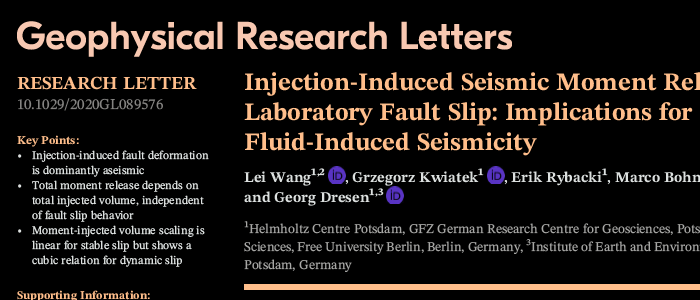Lei Wang published another paper “Injection-Induced Seismic Moment Release and Laboratory Fault Slip: Implications for Fluid-Induced Seismicity” related to his recent injection experiments on two saw-cut Bentheim sandstone samples. The paper has been published in recent issue of Geophysical Research Letters. The paper is the fourth paper from our group (see previous papers published in Science Advances and two papers in GRL) that aims to identify seismo-mechanical parameters that would allows us to forecast in near-realtime the deviation from stable rupture conditions.
Key points from the paper:
- Injection-induced fault deformation is dominantly aseismic
- Total moment release depends on total injected volume, independent of fault slip behavior
- Moment-injected volume scaling is linear for stable slip but shows a cubic relation for dynamic slip
Reference:
Wang, L., G. Kwiatek, E. Rybacki, M. Bohnhoff, and G. Dresen (2020). Injection-Induced Seismic Moment Release and Laboratory Fault Slip: Implications for Fluid-Induced Seismicity. Geophysical Research Letters 47, e2020GL089576, DOI 10.1029/2020GL089576.
Abstract:
Anthropogenic earthquakes caused by fluid injection have been reported worldwide to occur in the frame of waste-water disposal, CO2 sequestration and deep geothermal system projects. To study the dynamics of injection-induced seismic energy release in controlled environment, we performed laboratory fluid injection experiments on critically stressed high-permeability sandstone samples with a prefabricated fault. We monitored acoustic emissions occurring during injection-induced fault sliding. We found that the total seismic deformation (expressed in total seismic moment) is related to total injected volume, independent of fault slip modes (i.e., dynamic slip, steady slip and fault creep). Seismic moment release rate roughly scales with fault slip velocity. In our experiments, the fluid pressure front migrates faster than the rupture front by about five orders of magnitude, resulting in fault slip within a zone of homogeneous fluid overpressure. We found the cumulative seismic moment scales linearly with the injected volume for stable slip (steady slip and fault creep) while it follows a cubic relation for dynamic slip. Our experimental results suggest that the deviation of monitoring cumulative moment release with injected volume from a linear trend in practice might be a sign for potential seismic risk. This may be considered in modifying current injection strategies.
